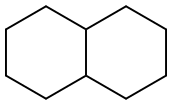91-17-8

Product Name:
Decahydronaphthalene
Formula:
C10H18
Synonyms:
Decahydronaphthalene;Decalin
Inquiry
CHEMICAL AND PHYSICAL PROPERTIES
| Physical Description | Decahydronaphthalene appears as a clear colorless liquid with an aromatic odor. Flash point 134 °F. Less dense than water and insoluble in water. Vapors heavier than air. |
|---|---|
| Color/Form | Clear colorless liquid |
| Odor | Slight odor resembling menthol; pure decalin does not smell of naphthalene |
| Boiling Point | 383 °F at 760 mmHg (USCG, 1999) |
| Melting Point | -44 °F (USCG, 1999) |
| Flash Point | 134 °F (USCG, 1999) |
| Solubility | Very sol in alcohol, methanol, ether, chloroform. Miscible with propyl and isopropyl alcohol; miscible with most ketones and esters. |
| Density | 0.89 at 68 °F (USCG, 1999) - Less dense than water; will float |
| Vapor Density | 4.76 (Air= 1) |
| Vapor Pressure | 2.3 [mmHg] |
| LogP | 4.6 |
| Stability/Shelf Life | On long exposure to air forms dangerous concentration of peroxide. |
| Autoignition Temperature | 482 °F (USCG, 1999) |
| Decomposition | When heated to decomposition it emits acrid smoke and fumes. |
| Viscosity | 1.788 cP @ 70 °F |
| Heat of Combustion | -19,200 BTU/lb= -10,700 cal/g= -447x10+5 J/kg |
| Heat of Vaporization | 130 BTU/lb= 71 cal/g= 3.0x10+5 J/kg |
| Surface Tension | 30 dynes/cm= 0.030 N/m at 20 °C |
| Kovats Retention Index | 1090 1078.85 1086.83 1092 1085 1096 1096 1109 1130 1090 1097 1097 1102 1081.5 1087 1120 1132 1085 1124.8 1137.7 1106 1093 1097 1082 1103 1099 1092 1101 1116 1124 |
| Other Experimental Properties | MP: -42.9 °C; BP: 195.8 °C; density: 0.8999 @ 20 °C; index of refraction: 1.4695 @ 20 °C; insoluble in water; miscible in ethanol; very soluble in ethyl ether, acetone, benzene; chloroform /cis-Form/ |
| Chemical Classes | Other Classes -> Naphthalenes |
SAFETY INFORMATION
| Signal word | Danger |
|---|---|
| Pictogram(s) |
 Flame Flammables GHS02  Corrosion Corrosives GHS05  Skull and Crossbones Acute Toxicity GHS06  Health Hazard GHS08  Environment GHS09 |
| GHS Hazard Statements |
H226:Flammable liquids H304:Aspiration hazard H314:Skin corrosion/irritation H331:Acute toxicity,inhalation H410:Hazardous to the aquatic environment, long-term hazard |
| Precautionary Statement Codes |
P210:Keep away from heat/sparks/open flames/hot surfaces. — No smoking. P280:Wear protective gloves/protective clothing/eye protection/face protection. P301+P330+P331:IF SWALLOWED: Rinse mouth. Do NOT induce vomiting. P303+P361+P353:IF ON SKIN (or hair): Remove/Take off Immediately all contaminated clothing. Rinse SKIN with water/shower. P305+P351+P338:IF IN EYES: Rinse cautiously with water for several minutes. Remove contact lenses, if present and easy to do. Continuerinsing. |
COMPUTED DESCRIPTORS
| Molecular Weight | 138.25 g/mol |
|---|---|
| XLogP3 | 4.6 |
| Hydrogen Bond Donor Count | 0 |
| Hydrogen Bond Acceptor Count | 0 |
| Rotatable Bond Count | 0 |
| Exact Mass | 138.140850574 g/mol |
| Monoisotopic Mass | 138.140850574 g/mol |
| Topological Polar Surface Area | 0 Ų |
| Heavy Atom Count | 10 |
| Formal Charge | 0 |
| Complexity | 80.6 |
| Isotope Atom Count | 0 |
| Defined Atom Stereocenter Count | 0 |
| Undefined Atom Stereocenter Count | 0 |
| Defined Bond Stereocenter Count | 0 |
| Undefined Bond Stereocenter Count | 0 |
| Covalently-Bonded Unit Count | 1 |
| Compound Is Canonicalized | Yes |
PRODUCT INTRODUCTION
description
Decahydronaphthalene appears as a clear colorless liquid with an aromatic odor. Flash point 134 °F. Less dense than water and insoluble in water. Vapors heavier than air.
